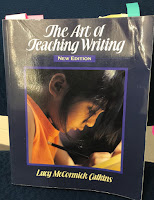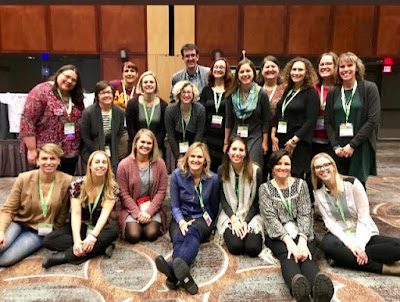Endurance Part 2: How Do We Build Endurance from Day 1?
In my last post, I advocated for building endurance in our readers and writers by planning what foundational skills our students will need and by getting to know the students as individuals. Today we'll take a look at starting to build endurance from the first day of school by doing three things.
Here are THREE small important steps to start building endurance:
Here are THREE small important steps to start building endurance:
1. Get a timer. Put one on your Smart Board, wear one on your wrist, get one on your phone, or buy an old-fashioned kitchen timer. Time is a tangible representation of growth. I use the timer for everything at the beginning of the year - reading, writing, talking (my directions and kids sharing in partnerships and groups). I can't be deeply thinking about our lesson or how students are doing if I'm watching the clock. A timer takes away this burden. It also give kids a concrete stopping point - they are more likely to feel they can try something if it won't last forever.
 2. Build Anticipation: I remember when I first read Lucy Calkins' book, The Art of Teaching Writing. I was struck by the beautiful process of introducing Writer's Notebooks. Calkins describes a teacher inviting her students to be writer's, not getting them to do it. "Isoke used this writing workshop as a time to demonstrate the role writing plays in her life and to invite students to join her in living the writerly life" (p. 28). High school teachers often think some methods only work for elementary or middle schools. It's not true. Older kids benefit from easing into both reading and writing through anticipation, and they definitely benefit from imagining possible futures for themselves. When we slowly share our own notebooks, we modeling what others do, we show students a glimpse of what they might do, and this builds confidence. They too can be writers.
2. Build Anticipation: I remember when I first read Lucy Calkins' book, The Art of Teaching Writing. I was struck by the beautiful process of introducing Writer's Notebooks. Calkins describes a teacher inviting her students to be writer's, not getting them to do it. "Isoke used this writing workshop as a time to demonstrate the role writing plays in her life and to invite students to join her in living the writerly life" (p. 28). High school teachers often think some methods only work for elementary or middle schools. It's not true. Older kids benefit from easing into both reading and writing through anticipation, and they definitely benefit from imagining possible futures for themselves. When we slowly share our own notebooks, we modeling what others do, we show students a glimpse of what they might do, and this builds confidence. They too can be writers.
With reading, I build anticipation with book talks. I introduce 3-4 books daily - really good, juicy books that will hook a lot of kids (my day #1 choices: Crank by Ellen Hopkins, Runner by Carl Dueker, and What Happened to Cass McBride? by Gail Giles). We do this for several days before we have a Book Tasting where I set up the desks in pods of four, and put bins of 8-10 books on each pod. The bins are a mix of books some kids might have read before (to them talking about the books) and books that have hooked in my readers previously. No classroom library? Read this post to see why you should start one (http://blue-skyteaching.blogspot.com/2016/03/a-classroom-library-in-high-school.html). Kids walk around and sample books from all the bins, while jotting down titles they might consider reading. After this, they are itching to get into books. They will choose their first book after Book Tasting, and book talks and listing potential reads will continue all year long.
3. Start smaller than you can imagine: At the beginning of the year, I talk a lot about summer brain - how slowed down and relaxed we get (well, maybe not teachers...) during those hot, hazy days of summer. We can read and fall asleep. We can write and gaze off into space daydreaming. We can do nothing. Our brain slows down and adjusts nicely to this nonchalant pace. And then BAM! We're back and teachers are all wanting us to sit up, be alert, do this work, and hurry all class period long. Don't do this to kids. Slow down and let them know you get it; you know how they feel.
Writing Our first writing happens on Day One and is three minutes long. Yep. THREE. This is 100% intentional. First, I want all my kids to have success. I want as many kids as possible begging for more time, telling me that three minutes was way too short. My response when this happens (which it always does) is, "Yeah. I don't want to stress you out. It is the first day." More pleading. "OK, I supposed I could give you two more minutes." This may happen more than once, but I want to make sure I cut them off wanting more.
This leads to the second reason for going short: everyone can grow. If we start at three and then jump to five the next class period, everyone has shown growth, and depending on how it goes, I'll only add 1-2 minutes per class period to our writing time. Anyone can do just 1 extra minute, right? Within two weeks, they'll be writing for a good chunk of time. Don't be afraid to go slowly. You want success!
This leads to the second reason for going short: everyone can grow. If we start at three and then jump to five the next class period, everyone has shown growth, and depending on how it goes, I'll only add 1-2 minutes per class period to our writing time. Anyone can do just 1 extra minute, right? Within two weeks, they'll be writing for a good chunk of time. Don't be afraid to go slowly. You want success!
Within the first two weeks of school, I will have students read an article about the myth of multi-tasking (here are two ideas: http://www.thenewatlantis.com/publications/the-myth-of-multitasking; or https://www.psychologytoday.com/blog/creativity-without-borders/201405/the-myth-multitasking), and we will talk about our plan for independent reading time. Can we have phones and iPads in use while we are engaged in our independent books? In three years in a one-to-one high school, I have had my students unanimously agree that they cannot stay focused in their books with their devices out on the desk next to them. Even if their notifications are turned off, they feel like their devices are calling them - Maybe someone posted something? Maybe someone messaged me? What am I missing? When the device is out of sight, students didn't think about it as much. We have a lot of uses for technology in my room, but independent reading time, especially at the beginning of the year when we're building endurance, is not one of them.
The second benefit of starting with small amounts of time is that struggling and resistant readers often fear of big chunks of time. They don't really know how to pick books yet. They need to develop confidence first. And if I can see who's looking extremely uncomfortable, who's wiggling in his or her seat, who's eyes are darting around to see what everyone else is doing, I can target who needs my help. I don't need to check in with kids who jump right in to their books (yet). I need to support the kids who may be in the wrong book, who may not know what to do with that book, who may not know that all readers experience some confusion at the beginning of a new book.
Starting with these small steps and a conscious choice to build endurance will make a difference in your classroom. Yes, you slow down at the beginning, but just like with sports, focusing on endurance at the beginning will pay off later on. You can have the best skilled athletes, but if they can't last the whole game, they're not going to be successful. We have big plans for our readers and writers later on in the year. The beginning is the time to make sure they're in shape to handle the challenges.
I wish this were the end of this series on endurance, but it is not. Endurance is an on-going practice, as anyone who does a sport can attest. You can't just run at the beginning of the season and think you'll stay in shape. We will need ways across the school year to re-invigorate our students. However, the steps in this post are enough to get you thinking and planning for the start of school.
Do you have other ways you build endurance in your students? I'd love to hear them!
I wish this were the end of this series on endurance, but it is not. Endurance is an on-going practice, as anyone who does a sport can attest. You can't just run at the beginning of the season and think you'll stay in shape. We will need ways across the school year to re-invigorate our students. However, the steps in this post are enough to get you thinking and planning for the start of school.
Do you have other ways you build endurance in your students? I'd love to hear them!




Comments
Post a Comment